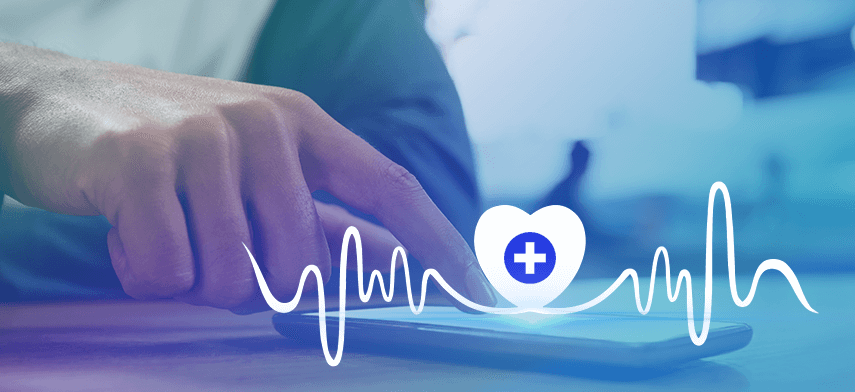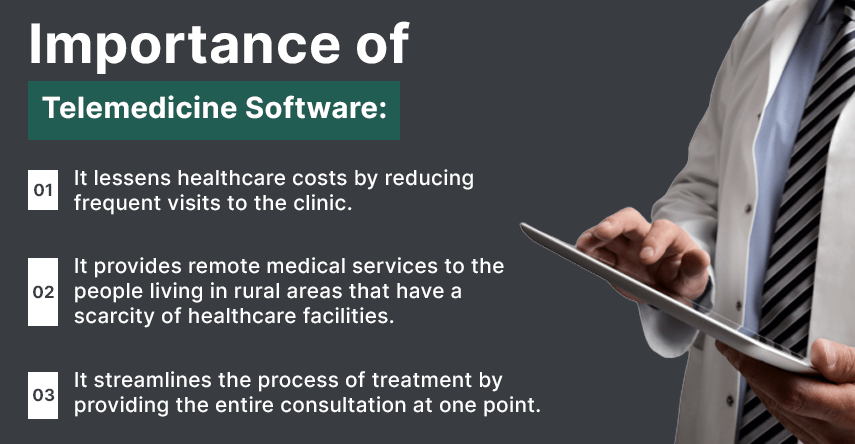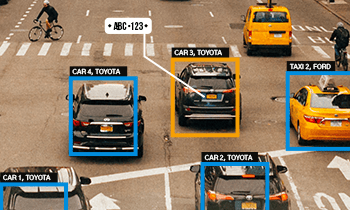The concept of telemedicine can be summed up in a single line – providing healthcare services remotely. It helps healthcare professionals to send help in remote locations through telecommunication. The medical practitioners can diagnose, analyze, and treat patients efficiently and immediately, saving their expense of travel. It comprises the use of software and electronic communications to provide telemedicine solutions for patients, without in-person visits to clinics. The telemedicine software development industry is picking pace in the market due to rising people’s inclination towards remote and virtual healthcare system.

Due to the emergence of several remotely accessible healthcare innovations like mHealth, eHealth, telehealth, telemedicine, they are used interchangeably. However, there is a very thin line separating these terms, and one needs to be able to differentiate among them. Let us see how they are different from each other.
The Major Difference Between Telemedicine and mHealth is:
Telemedicine uses medical data via the electronic mode of communication to treat the patient or improve their health. It uses wireless devices, e-mails, videos, and smartphones to communicate with patients.
Whereas mHealth deals with the practice of public health and medicines using mobile devices. This is user-directed technology. The term is specifically coined for the healthcare treatment provided to the patient, involving the usage of smart devices like tablets, phones, and wearables like fitness trackers.
The Emergence of Telemedicine Software Solution in Industry
With the growing prevalence of telemedicine in the healthcare sector for remote patient care, most of the companies are turning towards investing in telemedicine software solutions. The patients and healthcare practitioners use telemedicine software to remain connected with each other through images and video platforms.
With a considerable percentage of people living in the rural areas of the world, providing them with proper healthcare facilities is very difficult. Physicians and other healthcare experts are working consistently to help them with quality healthcare facilities. One such innovation is telemedicine. With the advent of certain telemedicine software development, healthcare experts can provide remote medical services to the patient. This software is booming in the market due to increasing demand and rapidly growing adoption rates.
Some of the Key Factors Fueling the Demand For Telemedicine Software are:

The telemedicine software can assist specialists to be present with the patient by their bedside. Besides, the telemedicine software for clinics helps pharma companies and medical researchers to provide various testing options on different subjects, along with conducting clinical trials.
Market Scenario of Telemedicine Software
The telemedicine software industry is growing by the minute. In an urgent need to provide healthcare and medical service in remote areas, the increasing number of companies are investing in this market. The growing number of centers have already started working and implementing telemedicine technology in their treatment methods. The technological advancement in the information and communication industry is the key factor behind the growth in the overall healthcare sector, impacting telemedicine as well. Thus, the demand and ROI in the telemedicine software market will surge in the coming years. The exploration of telemedicine in the field of cardiology, radiology, behavioral health, and others, along with the growing number of people adopting e-visits for medical treatment, are fueling the market growth.
Based on the application, the telemedicine industry is broadly categorized into telepsychiatry, teleconsultation, teledermatology, telestroke, and others. All these segments have their individual importance and, thus, have a huge scope to be converted into telemedicine software to help the patients reach physicians remotely.
Drivers Fueling Growth of Telemedicine Software
Innovations in the telemedicine sector have made healthcare services easily accessible and affordable for people. The market will develop as highly competitive, owing to the emergence of healthcare giants, new entrants, and startups. Some of the key growth drivers responsible for the market developments are:
- Modification in telemedicine policies strengthens the hold in the global market.
- The number of service providers is increasing in the telemedicine software market.
- Virtual consultation practice is gaining attention among patients and physicians.
- Time-saving ability and efficiency of telemedicine software to generate market demand.
- Besides, rising virtual consultation software, development in Electronic Health Records (EHR), and revised reimbursement policies fuel the market growth.
- The increasing elderly population is another driver contributing to the rising demand in the market for telemedicine software.
Let’s Explore Key Features of Telemedicine Solution
The telemedicine software enables the healthcare practitioners to have live video calls between the physician and the patient, diagnose them, and recommend the treatment method to them. It incorporates applications that empower medical practitioners to connect with patients incapable of traveling or are situated in remote areas. Telemedicine software has three different modules for patients, healthcare providers, and the admin of the software.
Patient Module:
- This module allows easy authentication for the patient, where they can simply sign up using their phone number or e-mail ID to use the software. This software is available for iOS as well as Android smartphones to access conveniently.
- The patient can then browse through the list of physicians available for them. On clicking the physician’s name, patients can look at their profile, where they can go through the qualifications, specialty, and reviews given by other patients. Patients can also mark the physicians as a favorite.
- After selecting a suitable physician, the patient can book the appointment as per the physician’s and patient’s availability. Then, the patient can have a video consultation, which is two-way communication between both. Besides, patients also have the option to get on audio consultation with the physician.
- In addition, the patient can go through its past appointments with the physicians in the history section. It also allows the patient to give reviews and ratings to the physicians for better feedback.
Provider Module:
- The module allows the secure onboarding of the patient through the phone number or their email ID. In this module, the physicians can add their profile along with their contact details, qualifications, availability, experience, and testimonials.
- The telemedicine app for physicians can check their entire schedule for the day and week to manage their appointments. In fact, they can also add appointments manually. Besides, they can also keep track of past appointments with the patient and the appointments scheduled for the future using activity records.
- The module also sends regular reminders to the physician about the upcoming appointments. The provider can also set their availability in the calendar so that the patient can select a suitable date accordingly. On consultation, the module allows the physician to create a prescription for the patients and share it with them with all the necessary details through email.
- The module also has a feature of integrated billing where they can charge the consultation fees after the remote visit, allows them to answer patient queries, and check the feedback given by the patient, which will help them improve their online consultation practice.
Admin Module:
- This module makes the manager keep a check and control all the features of the physician and patient module, along with custom integrations based on the company’s requirement.
- It has a dashboard that enables the admin to check the key stats of the online hospitals, with contact numbers, healthcare providers, engagements, and patients. It also manages the registered healthcare providers and assists them in technical support, when needed. Similarly, it manages patients as well.
- It allows the admin to keep track of all the appointments handled, canceled, rescheduled, or missed by the patients. Moreover, it helps manage the notifications that patients or physicians require, through their interface. It helps both the parties to remain updated.
Technologies Used in Telemedicine
As the telemedicine industry is growing significantly, several technologies are implemented to develop the best solution for the users as well as the healthcare providers. This intends to gain improved user satisfaction, quick access, and ROI for the companies investing in it. For this telemedicine software development, the best tech stack is required for the advanced result:
1 Electronic Medical Records Systems and Electronic Health Records
EMRs and EHRs are the technologies store patient history and other details. They are helpful in easy access to patient records without having to search in papers. Besides, it is made sure that these pieces of information are highly secured and can be used only by the authorized person.
2 WebRTC
Features such as screen sharing, secured voice communications, store the data, transfer the records and important details, deployment of text messages, live video calls are all carried out using WebRTC. It is a mobile application and web browser technology. It helps in real-time communication through easy application programming modules.
3 Cloud-based Server Solutions
Due to the generation of a huge amount of data and its storage issues, cloud technologies are an important tech stack for telemedicine software. HIPAA compliant telemedicine software videos are also created using this. Thus, it is helpful in the management, storage, and exchange of data on the cloud.
4 HealthKit Integration: Google Fit and Apple HealthKit
Since telemedicine software is mainly developed for the Android or iOS operating system, it usually requires a health-tracking solution, like Apple Health Kit and Google Fit. The former comprises CareKit, HealthKit, and the ResearchKit, collectively forming the ecosystem. However, the latter is more focussed on healthcare data and aims to set fitness goals. These solutions are used to build telemedicine software along with health-monitoring functionalities and enable data transfer between the patient and the physician.
5 Interactive Voice Response (IVR)
Simply put, IVR is the technology used for telephony. It helps computers to interact with humans using an IVR script with DTMF tones and voices. It detects a dial pad for segmentation, identification, and routing the calls towards the appropriate use of the software.

How to Select Best Telemedicine Solution
With so many options of telemedicine software for physicians in the market, it might become difficult for healthcare providers to select the best or suitable software for their patients. So, here are a few guidelines that would help in choosing the appropriate telemedicine solution.
- There are three main types of telemedicine software for hospital-based, physician-centric, patient-oriented. Understand your requirements and point of focus, and then think about which one to go for.
- Create your business goals and get clarity with your team members for all the factors behind choosing the respective type.
- Go thorough market research and understand the existing products in detail.
- Approach multiple solution providers and get a quote from them after discussing all the requirements. Once you streamline on the solution provider, ask them for a demo version to check the functionalities. This will help analyze the software and its performance and take a final call.
Wrapping up,
The future scope of the telemedicine software platforms majorly depends on the economy of the country it is expanding in, technological developments, and human behavior (acceptance and adoption). Besides, the lack of skilled healthcare practitioners and lessening third-party reimbursement are some of the major factors contributing to the upcoming growth of the industry.

Author's Bio

Shailendra Sinhasane (Shail) is the co-founder and CEO of Mobisoft Infotech. He has been focused on cloud solutions, mobile strategy, cross-platform development, IoT innovations and advising healthcare startups in building scalable products.


